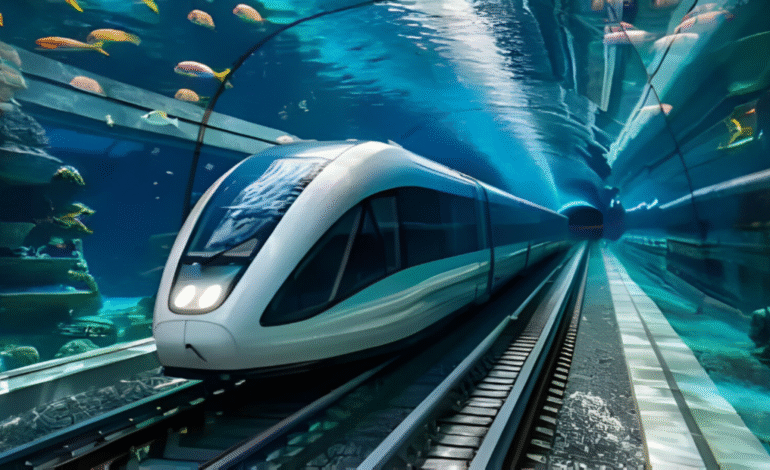Underwater Bullet Train: Dubai To Mumbai High‑Speed Link

In a bold move set to redefine transportation and global connectivity, the United Arab Emirates has unveiled visionary plans for the world’s first underwater bullet train connecting Dubai and Mumbai. This high-speed marvel, stretching over 1,200 miles beneath the Arabian Sea, promises not only to change how people travel but also to transform the way the world views infrastructure, tourism, and bilateral cooperation between nations.
This undersea rail connection, proposed by the UAE’s National Advisor Bureau, is no longer a distant dream but an active ambition. With plans to reach unprecedented speeds of 600 to 1,000 kilometers per hour, the Dubai-Mumbai bullet train would not only be faster than most commercial flights but also more scenic, thanks to transparent tunnel walls offering panoramic views of the marine world.
Bridging Continents: More Than Just a Train
The proposed underwater train is far more than a technological marvel. It serves as a powerful symbol of cooperation between India and the UAE, two nations with thriving trade relations and deep-rooted cultural ties. According to Dr. Ahmed Al Hariri, leading the initiative, “This is not just about transport, but an immersive experience.”
The tunnel aims to deliver a journey that feels like a futuristic marine adventure. Unlike traditional railways or aircraft, passengers will be able to witness life beneath the sea through large, transparent windows. The train is also being designed with dual-purpose capabilities: transporting both passengers and vital cargo such as freshwater and oil. With India’s growing demand for oil and the UAE’s requirement for freshwater, this system could become a critical supply artery between the two nations.
A Strategic Leap in Trade and Tourism
Both nations are not only investing in the infrastructure but also envision the economic possibilities it opens. For Dubai, the bullet train isn’t merely a futuristic transport mode; it’s a direct pipeline for deeper trade partnerships, increased tourism, and global prestige.
With Dubai positioned as a tourism and business hub in the Middle East, the underwater train is expected to bolster the UAE’s standing as a global innovator. It competes directly with other regional projects like Saudi Arabia’s $1 trillion NEOM, a futuristic mega-city. If the Dubai-Mumbai bullet train launches before NEOM fully materializes, it could provide Dubai with symbolic and economic supremacy in the race for the region’s most advanced infrastructure.
Sara Ahmed, a well-known Dubai-based travel blogger, puts it succinctly: “The underwater train isn’t just about getting from point A to B. It’s about relishing the wonders of the marine world.”
Engineering a Modern Marvel Beneath the Arabian Sea
The ambition is massive, and so are the challenges. Constructing a 1,200-mile underwater bullet train beneath the Arabian Sea is not only a first-of-its-kind undertaking but also one of the most complex engineering tasks ever proposed.
Designers and engineers are already researching materials capable of withstanding extreme underwater pressure, high-speed vibrations, and long-term exposure to saline water. Preliminary designs suggest using transparent materials rather than traditional opaque concrete or bricks, allowing for an immersive aquatic experience.
Safety is a top concern. Maintaining structural integrity under deep-sea conditions, ensuring a pressurized environment for passengers, and dealing with emergencies in an underwater setting will require technological innovation beyond anything currently in use. The feasibility report under development will address these critical challenges.
Public Sentiment and Psychological Hurdles
While the project has sparked global excitement, not everyone is convinced. Public sentiment, particularly among those unfamiliar with underwater travel, remains mixed. Rajesh Verma, a businessman from Mumbai, shared his reservations: “I’ve always been wary of the ocean’s depths. As much as I love the idea, I’ll likely stick to conventional modes of transport.”
Claustrophobia, fear of water, and concerns over technological reliability are just a few of the psychological barriers developers must overcome. But Dubai has consistently demonstrated its ability to turn audacious ideas into functioning realities. From the Burj Khalifa to the Palm Islands, the city has defied expectations with projects once deemed impossible.
Financial Backbone and Political Willpower
Cost is another significant factor, but in Dubai, financing rarely stands as a barrier. While the project could run into billions of dollars, the UAE is more concerned about feasibility than funding. With state-backed support, international investors, and a clear strategic vision, financial backing for this undersea project seems likely to fall into place.
The political alignment between the UAE and India further strengthens the likelihood of success. Both nations have made joint statements about enhancing cross-border trade, tourism, and technology. The bullet train perfectly fits that shared vision.
Surpassing Existing High-Speed Rail Networks
If completed, the Dubai-Mumbai underwater train would surpass even the most impressive high-speed rail networks in Asia and Europe. Consider China’s extensive bullet train lines:
- Beijing to Kunming: 2,653 km
- Beijing to Guangzhou: 2,298 km
- Shanghai to Kunming: 2,066 km
- Tokyo to Hakata in Japan: 1,174 km
- Madrid to Barcelona in Spain: 621 km
Even Japan’s Seikan Tunnel, the world’s current longest undersea tunnel at 53.85 kilometers, pales in comparison. The proposed Dubai-Mumbai route is not just longer; it is ten times faster than existing undersea trains and offers a never-before-seen visual spectacle.
The Deep Blue Express: More Than a Commute
Dubbed the “Deep Blue Express” by early fans, this train could soon become a global bucket-list item. With scenic oceanic visuals, a commitment to comfort, and ultrafast travel time, it may redefine the entire concept of long-distance transportation.
Moreover, the design intends to deliver not just luxury and speed, but also sustainability. Planners are looking into minimizing the ecological footprint by using renewable energy sources and non-invasive tunneling methods. A detailed environmental impact assessment is expected to be part of the feasibility report.
A New Frontier in Connectivity and Innovation
By breaking geographical boundaries and defying engineering norms, the underwater bullet train positions itself as more than a mode of transport. It stands as a futuristic symbol of collaboration, daring, and ambition. If executed successfully, it would mark the beginning of a new chapter in how nations build, connect, and prosper.
As the world watches closely, Dubai and Mumbai are preparing to dive into uncharted waters, literally and metaphorically. This project isn’t just about speed or novelty it’s about leadership in global innovation.
What Lies Ahead: Challenges, Opportunities, and Global Impact
While the project is still in early stages, its impact has already begun rippling through the infrastructure and transport sectors. Engineers, investors, environmentalists, and geopolitical analysts are all turning their attention to this unfolding development.
Challenges such as water pressure, geological instability, and international maritime laws remain critical hurdles. There is also the issue of long-term maintenance and passenger safety protocols. Still, optimism outweighs doubt, and the potential rewards are monumental.
From eco-tourism opportunities and cargo logistics to scientific research and ocean preservation, this underwater tunnel could serve multiple secondary purposes that benefit humanity at large.
An Iconic Leap into the Future
The Dubai-Mumbai underwater bullet train may take years to materialize, but its announcement has already made waves. It’s a beacon of what’s possible when ambition meets innovation, when visionaries dare to go deeper both literally and symbolically.
By bringing this pioneering concept closer to reality, the UAE has once again showcased its role as a global leader in reimagining tomorrow. The Deep Blue Express is no longer just a dream; it’s the next frontier in world travel, trade, and technology.








1 Comment
[…] RTA’s decision to extend Dubai Metro hours on July 20, 2025, reflects Dubai’s commitment to providing convenient public transportation […]
Comments are closed.